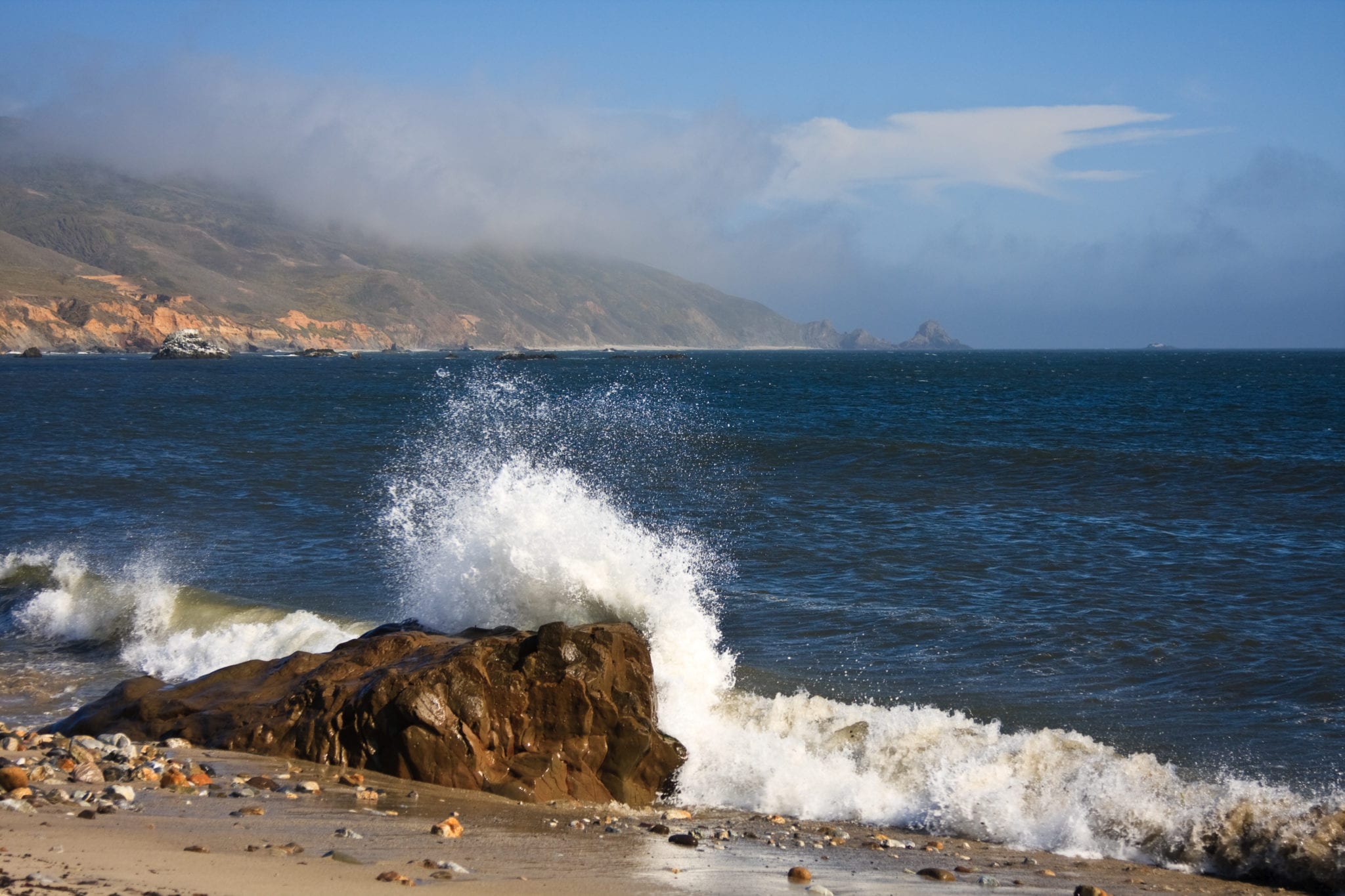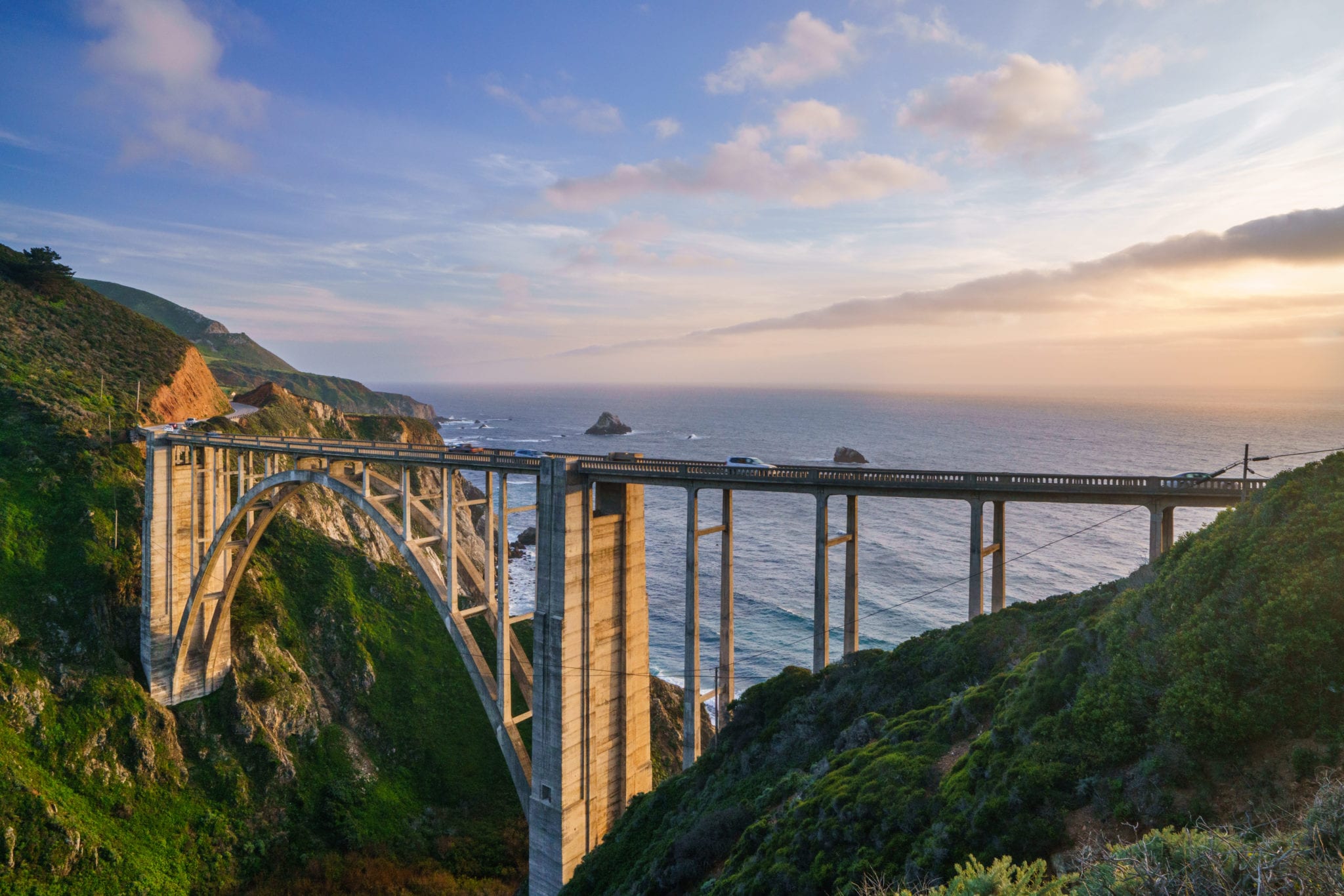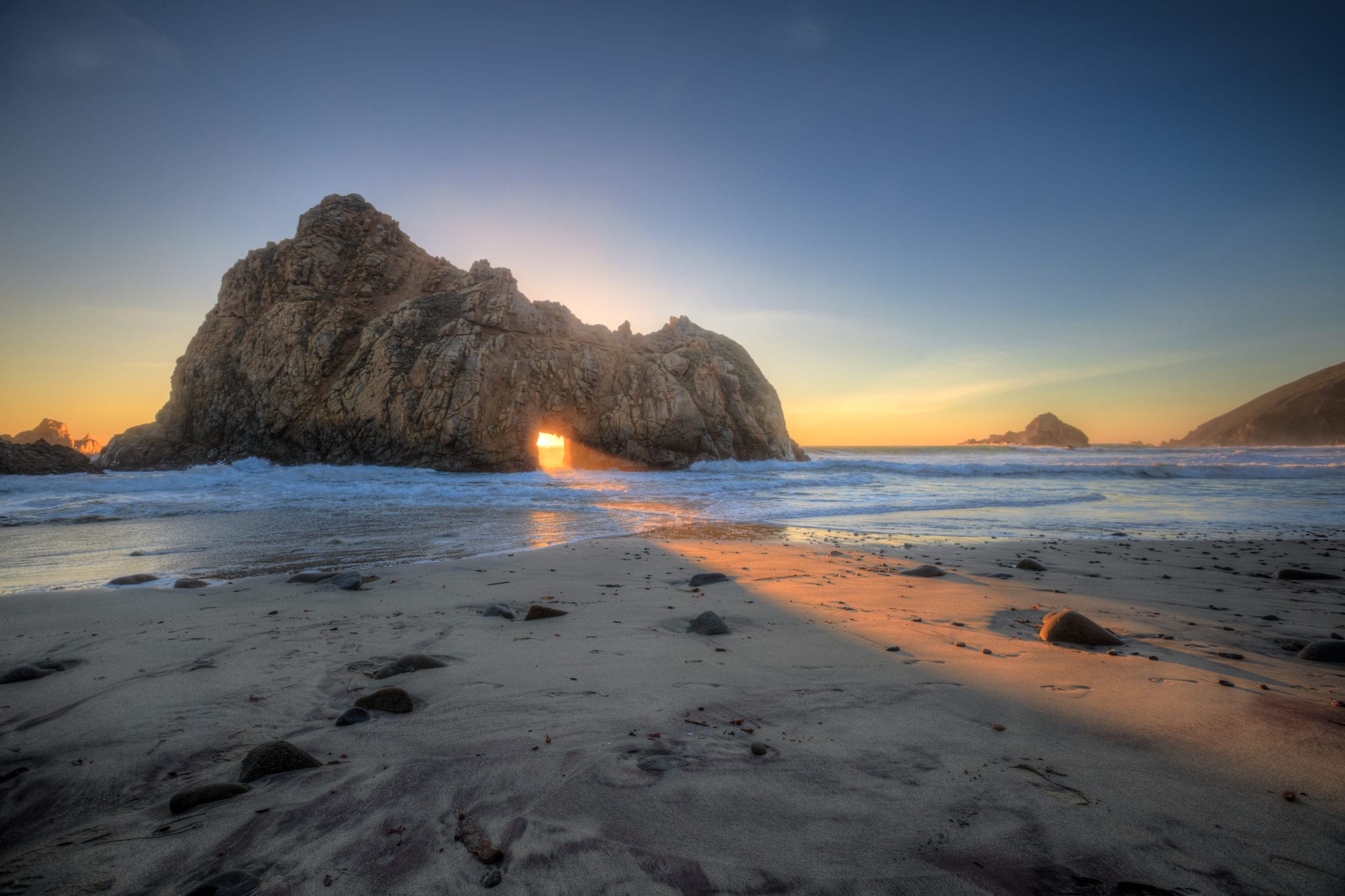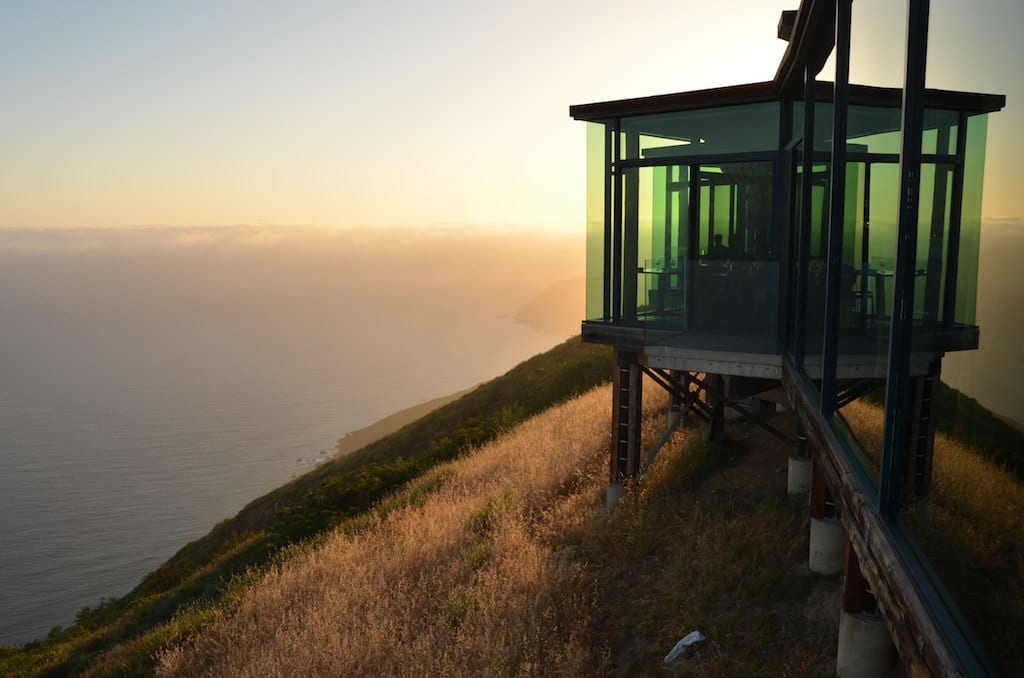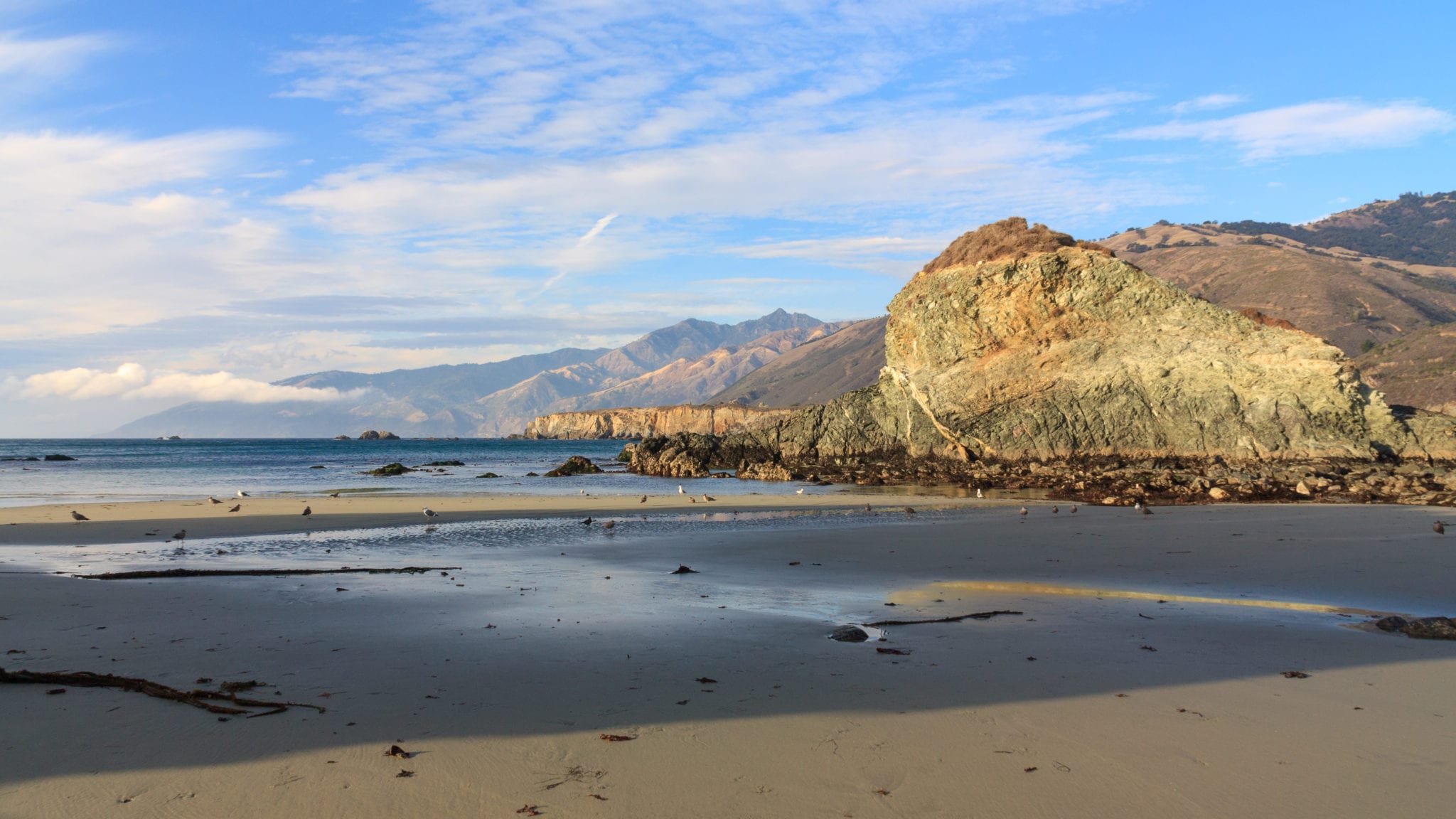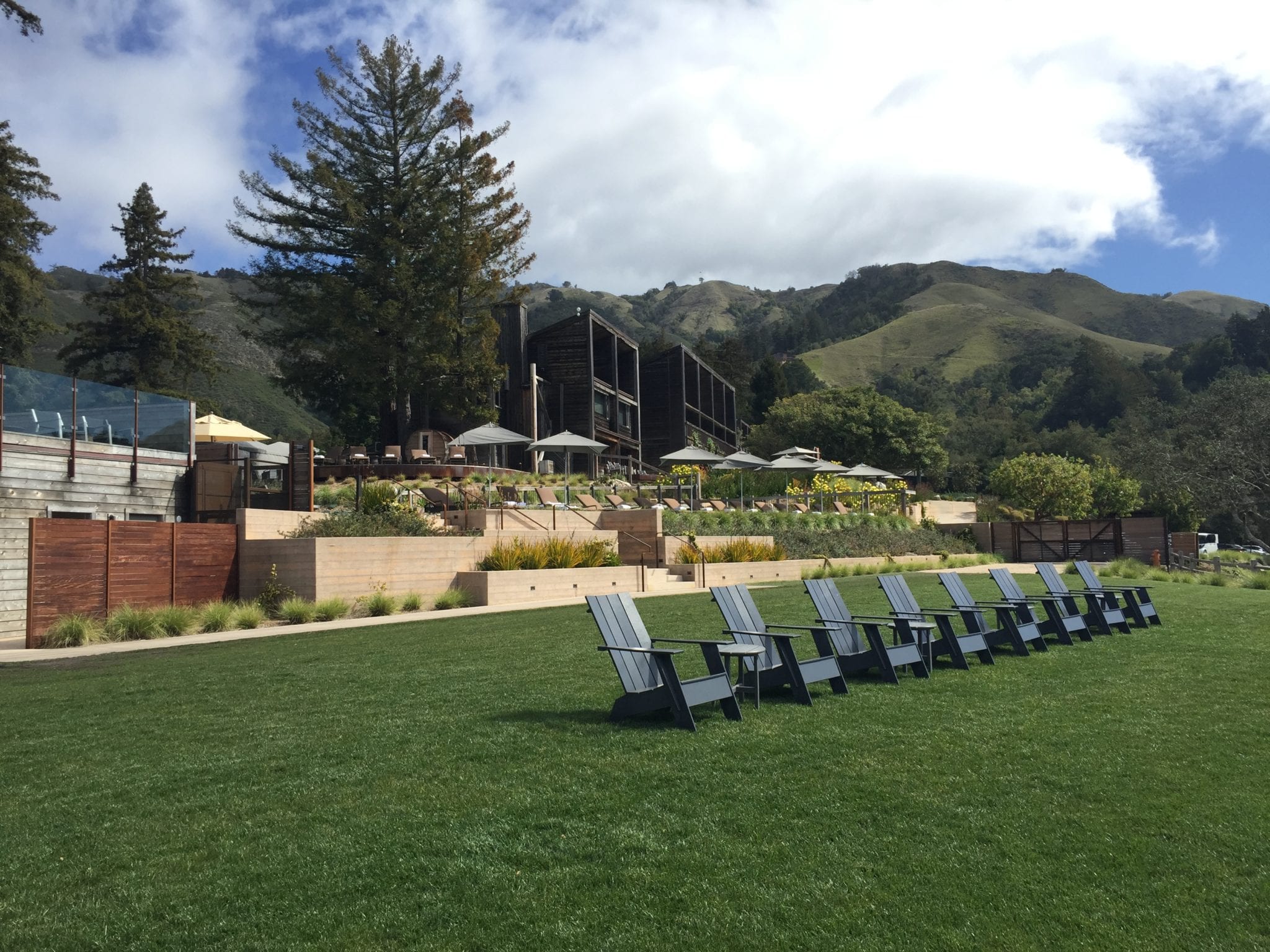Big Sur
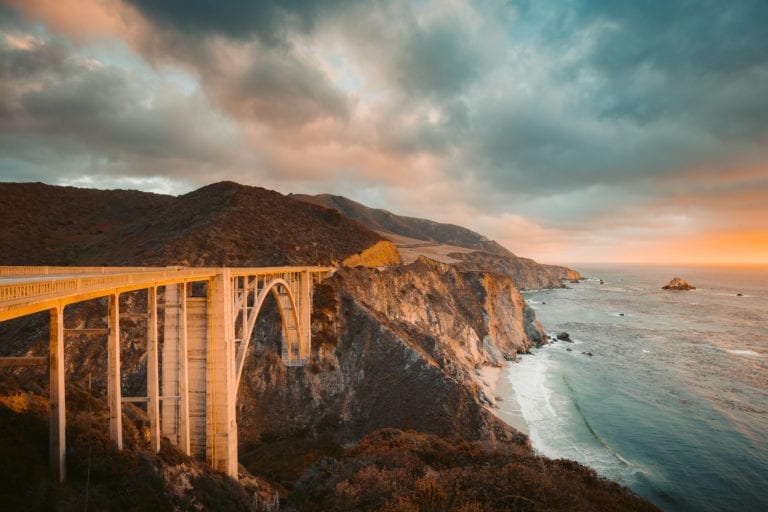
At the heart of Central California’s misty, mountainous coast lays postcard-perfect Big Sur, beckoning elopers who seek ample views of curling Pacific Ocean waves from rugged bluffs. However, Big Sur’s precarious positioning—hugging Highway 1, bordered by the Pacific on the west and the Santa Lucia Mountains to the east—has, in recent years, put it at odds with Mother Nature. In 2017, storm-induced mudslides first severed its Pfeiffer Canyon Bridge near Big Sur’s northern edge, and later, destroyed its southern patch on Highway 1—but massive renovations in 2018 restored them both, so no need to helicopter in anymore.
While there, do like Bob Dylan and be sure to visit the Esalen Institute, which offers soaking tubs heated by natural hot spring, and Nepenthe, an ocean-view restaurant that sits on the site where a cabin purchased by Rita Hayworth and then-husband Orson Welles once stood. Because Big Sur is small, respect the land and locals. Stay on path; don’t throw your bouquet over the cliff for the sake of a shot; and don’t leave anything behind. And know that your cell service might be iffy, so be sure your arrangements with your photographer, officiant, and anyone else are airtight should you not be able to get ahold of them.
And also, a note on eloping in California State Parks, many of which are in Big Sur and make for great elopements: California is hip to the times, meaning its State Parks have an established permit situation for elopements. Essentially, you’re good to go if you’re having no more than ten people (this includes yourselves and vendors), no food or alcohol, and no “decorations” beyond the bouquet (but we bet you could sneak in a boutonnière). Apply at least 30 days in advance; you’ll need to pay a filing fee of $25, along with a $275 four-hour permit fee if your application is accepted (plus a $10 fee per car, a refundable damage deposit, and in some cases, a park monitor fee). Because proof of liability insurance may be required 60 days ahead of your event if vendors are involved, it’s best to get the ball rolling as soon as you’re set on a State Park ceremony and have had a chance to scout your preferred location. Here’s where to start the application process.
Best Time of Year to Visit
September - October
Many images of Big Sur feature the area’s resident fog—a marine layer that blankets the coast, stretching inland on summer mornings and typically staying put until mid-afternoon. Though from some angles it can add an ethereal, otherworldly tinge to the landscape, it can also block visibility and natural light, potentially thwarting your photographer’s best efforts. If you’d like to avoid it, skip the height of peak fog (June through August) and visit in the weeks following. You’ll have clearer days, and even though the temps start to cool, the Pacific Ocean moderates the climate, keeping highs in the 60s and 70s and lows in the 50s. Not to mention the area’s wildlife activity, which swells in the fall with sightings of blue and humpback whales on the horizon, and monarch butterflies flitting throughout the area’s State Parks.
Pro Tip: Pack clothing for warm and cool weather, no matter when you visit. Given the area’s varying elevations, from mountain peaks to coastal dunes, the temperatures typically span a range of 10 to 20 degrees and also change dramatically with the shifting fog. Bring a rain jacket for sporadic showers (which are more frequent in winter) and comfortable shoes for treading on more rugged areas.
Featured Vendors
A 90-mile span of Highway 1, Big Sur packs in nearly a dozen State Parks. The largest one along the coast, Andrew Molera State Park near mile marker 51.2, is crisscrossed by miles of trails spanning meadows, bluffs, and hilltops. This Park also has beach access (not all do), and, since the beach is a mile walk from the parking lot, it’s usually less crowded than some of the area’s other beaches. If it’s between June and October, you’ll start out by crossing the Big Sur River on a footbridge; otherwise, you’ll wade through shallow water. Then head west along the Creamery Meadow trail, which is lined with sycamores and lush with wildflowers in spring and summer. The trail runs mostly parallel to Big Sur River, which spills into the ocean right next to Molera’s beach, creating some of the best conditions for surfing in the Big Sur area.
Bet you saw this one comin’: Bixby Bridge, deemed Big Sur’s version of the Golden Gate, is the trusty mascot of Big Sur, a majestic concrete bridge rising 260 feet above the canyon below. However, don’t be swayed by the lies of Instagram: the bridge is short—only about 0.1 miles long—and if you’d like privacy during your vows, which can be done sans permit on a lookout, you’ll want to head there at sunrise. Unless you thrive on crowds and fog, don’t go in August, which is peak tourist season. Or, if intimacy isn’t a priority, just go for it and embrace the tourists (they’ll probably love the sight of you and give you your space). Regardless, an experienced photographer should be able to nab the money shots that you came for.
Named after Julia Pfeiffer Burns, a lifelong Big Sur resident, rancher, and general bad-ass (several of Big Sur’s attractions bear the family name), this coastal park is a destination for hikers who don’t mind a bit of a trek to secure the best views. Though its towering Redwoods and tan oaks are a sight to behold in and of themselves, the Park’s must-see feature is McWay Falls, an 80-foot waterfall dropping from granite cliffs into the ocean below. Although the beach near the bottom is unfortunately closed to the public (due to the absence of a natural access point), you can still capture McWay in all its glory from an overlook on one of the Park’s trails. The sound of water crashing in the distance and the breathtaking panoramic views make this a dramatic locale to exchange vows.
Just north of the Park’s main entrance off Highway 1 is the turnoff for Partington Cove (also technically part of the Park), a rocky inlet accessible through a tunnel that used to house much of the area’s lumber shipping (and liquor smuggling) operations. Now, it offers a quiet, up-close view of the ocean via a small beach made up of medium-sized boulders.
Sycamore Canyon Road, the turnoff for Pfeiffer Beach, is the only paved, ungated road heading west off Highway 1 between the local post office to the south and Pfeiffer Big Sur State Park to the north. (Here, an important note: Pfeiffer Beach is part of Los Padres National Forest, and not in Pfeiffer Big Sur State Park.) Sycamore Canyon Road is only marked by a yellow “Narrow Road” sign—and it is, indeed, very narrow with several sharp turns, so you’ll have an easier time navigating it in a small vehicle as opposed to a larger one. Drive for two miles until the road opens into a parking lot ($10 fee), which has a short path leading to the beach. Pfeiffer Beach’s most prominent feature is Keyhole Rock, a large formation with a wave-carved arch through its center, allowing the colors of the sunset to stream through. Wander north on the beach, and you may also spot dazzling violet-hued sand, a product of sediment washed down from manganese garnet in nearby cliffs.
The California Parks department describes Pfeiffer Big Sur State Park as a rugged landscape jigsaw puzzle, which paints a rather accurate picture of how its many natural components fit together in seamless harmony—the Santa Lucia Mountains peaking overhead, the Big Sur River trickling below, and the massive redwoods rooting themselves practically everywhere in between. While taking a dip in the river is a popular afternoon recreation (pack a swimming suit for a post-ceremony splash), its banks have a lot to offer, too. An accessible trail looping around the river and shielded by a canopy of redwoods passes through several picnic areas with tables and grills (three of these are reservable with advanced notice). If you’re feeling more adventurous, opt for the Valley View Trail instead, known for its strenuous 750-foot climb and—just like its name promises—culmination at a stunning overlook with views of the Big Sur River Valley below.
As part of a legacy dating back to 1908, Pfeiffer Big Sur State Park is also home to Big Sur Lodge, a rustic 62-room hotel. For more than 30 years, the original settlers of the land hosted travelers in their ranch (once located in the same spot as the Lodge) before selling all of their 700 acres to the state—opting generously to preserve its natural beauty rather than take a higher offer from a hungry developer. Many of the Lodge’s cottage-style guest rooms, renovated in 2017, feature kitchenettes, fireplaces, and outdoor decks.
An intimate, upscale getaway nestled amid secluded mountain peaks, with guest rooms jutting out 1,200 feet above the Pacific Ocean, and, a bit further inland, tree houses on stilts, Post Ranch Inn occupies a chunk of land belonging to the Post family, one of the first to settle the area in the 1800s. Its original design by architect G. K. “Mickey” Muennig, which was later expanded by Vladimir Frank, is made of wood, stone, steel, and glass, and the inn is now recognized for major green initiatives—solar panels, Lexus Hybrid chauffeur service, and drought-resistant landscaping, among them.
The added bonus of pre-set elopement and “tiny wedding” (up to 10 people) packages here also streamlines the planning process. The former comes with a ceremony in a guestroom of your choice and an hour photography session, as well as a bouquet, a bottle of Champagne, and custom-etched flutes for $3,100 on Mondays through Thursdays and $3,600 on Fridays and Saturdays; the latter also includes a second bottle of Champagne, a cake, and a longer photo session for $5,000. In either case, a two-night minimum stay is required.
Much easier to scout out than Pfeiffer Beach, Sand Dollar Beach—where high tide leaves behind sand dollars and other gifts from the sea—is the longest continuous stretch of sandy coast in Big Sur, shielded from the area’s coastal winds by bluffs, i.e. you won’t get whipped in the face by sand, which is always good on very important life milestones. Sand Dollar beach sits a mile south of the U.S. Forest Service Station in Pacific Valley and is accessible by a parking lot across Highway 1 from Plaskett Creek Campground. (Campers at Plaskett, Kirk Creek, Ponderosa, and Nacimiento Campgrounds receive free day use at the beach, but otherwise, the fee is $10 per vehicle.) This portion of Big Sur’s southern coast also has natural reserves of jade, which you might spot along the inland part of the beach. If not, consider a two-mile trip south to the aptly named Jade Cove, home to greater quantities of the multi-colored stones, now a regular tourist attraction (although no stones can be removed at this point).
What happens when a sprawling, five-star resort with the works (spa, a slew of restaurants, “artisan-curated” minibars) meets a panoramic cliffside? Ventana Big Sur—the area’s resident, adults-only hub for an ultra-luxe escape. Though it’s always been a high-end locale, its recent multimillion-dollar renovation pushed its nature-chic accommodations to bougie new heights. All 59 rooms, suites, and villas now have their own balconies or patios, as well as soaking tubs and fireplaces.
As expected, Ventana is built for blow-out weddings, but its couples-focused lodging specials and upscale glamping offerings also make it a stunning spot for a private getaway for two. Exchange vows in a meadow surrounded by redwoods or on a secluded terrace overlooking the Pacific, then toast your newlywed status with vino selected from a 10,000-bottle cellar of Central Coast wines. Ventana’s pricing for elopements varies; enquire via this form for more information.
Marriage Laws
Big Sur is in Monterey County, which simply requires proof of age (you need to be 18 or older) and identification from each party (a state driver’s license, state ID, or passport) to receive a marriage license. If either person has been divorced or withdrew from a domestic partnership within 90 days of applying, he or she will also need to present a certified copy of the final divorce or withdrawal at the time of issuance.
You can either file your application for the license online at this link, and then visit the County Clerk’s office within two weeks, or complete the full process in-person instead. The fee is $85, and the license is valid for 90 days for ceremonies anywhere in California. For more information on marrying in Big Sur, see the County Clerk’s website.
